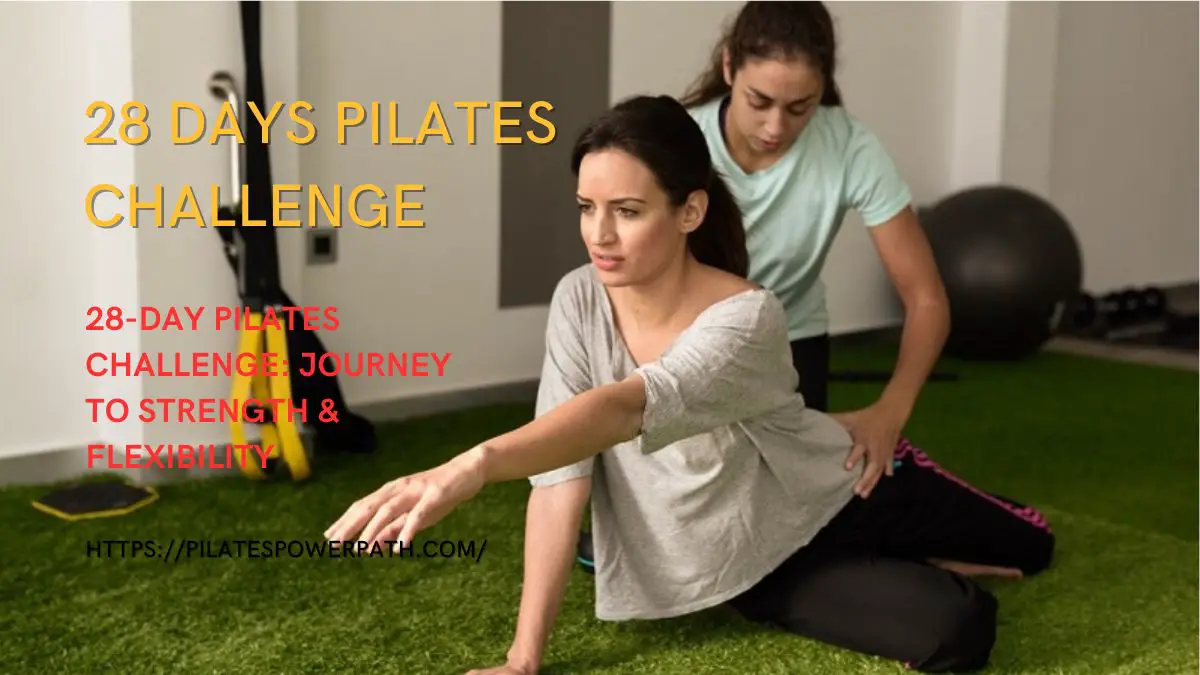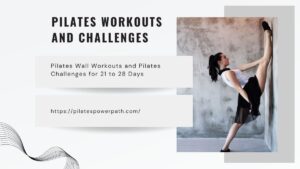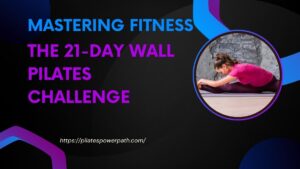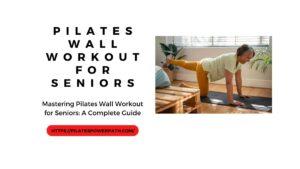28-day Pilates challenge, Pilates is a system of exercises designed to improve physical strength, flexibility, and posture, and enhance mental awareness. It focuses on core strength, balance, and flexibility. Incorporating Pilates into your regular fitness routine can improve posture, reduce stress, and handle daily tasks more efficiently.
The 28-day Pilates challenge aims to make a noticeable improvement in your fitness, body strength, and flexibility within a month. It’s structured to gradually increase the intensity and complexity of the exercises, allowing your body to adapt and grow stronger throughout the challenge.
By participating in the challenge, you can expect a transformation in your physical appearance and overall health and well-being. Consistent practice will make you more aware of your body, leading to improved posture and body mechanics. Your increased core strength and flexibility will make daily tasks easier, boost your confidence, and enhance your quality of life.
Week 1: Foundation Building
Day 1-4: Introduction to Pilates basics
In the initial week of the 28-Day Pilates Challenge, we set the groundwork with an introduction to the basic Pilates exercises. This stage is all about understanding the fundamentals of Pilates, familiarizing yourself with the techniques, and learning to engage your core effectively.
Day 1: We begin with a brief overview of Pilates principles, focusing on breath control, centering, concentration, control, precision, and flow. We then move on to simple exercises like The Hundred, The Roll-Up, and Leg Circles.
Day 2: Building upon what we learned on Day 1, we’ll introduce a few more exercises, such as Rolling Like a Ball and Single Leg Stretch, emphasizing fluidity in movement and core stabilization.
Day 3: On this day, we delve deeper into core work with exercises like Double Leg Stretch and Spine Stretch Forward, which improve flexibility and strength.
Day 4: Wrapping up the first week, we aim to consolidate the skills learned in the past three days with a comprehensive routine that engages the entire body.
Remember, the aim for the first week is not to perfect these exercises but to understand the mechanics behind them and learn to perform them with control and precision.
Read More: Transform Your Routine The 28-Day Busy Mom Pilates Challenge
Explanation of fundamental Pilates movements and their benefits
The Hundred: This exercise is a warm-up for the whole body, focusing on controlled breathing and activating the core muscles. It helps in improving circulation and developing abdominal strength.
The Roll-Up: The roll-up works on spinal articulation, engages the abdominals and stretches the hamstrings. It also improves posture and coordination.
Leg Circles: Leg circles focus on hip mobility and core stability, strengthening the abdominal muscles and improving flexibility.
Rolling Like a Ball: This exercise teaches control, balance, and coordination while massaging the spine. It also strengthens the abdominals and back muscles.
Single Leg Stretch: The single leg stretch targets the deep core muscles while incorporating a stretching element, enhancing flexibility and strength.
Double Leg Stretch: This exercise challenges the core and back muscles while improving flexibility, coordination, and balance.
Spine Stretch Forward: Spine stretch forward promotes spinal flexibility and stretches the hamstrings and back muscles. It also improves posture and reduces tension in the upper back.
Incorporating these fundamental Pilates exercises into your daily routine will not only improve your core strength but also enhance your overall physical and mental well-being.
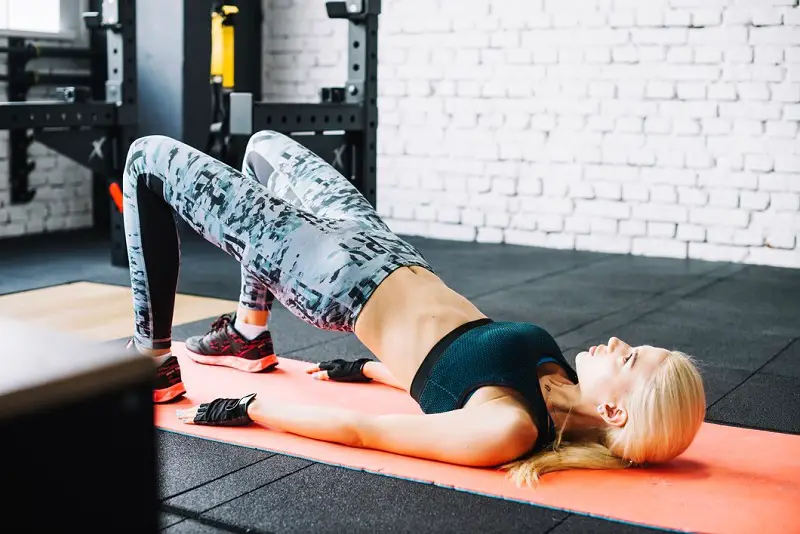
Day 5-7: Core Strengthening
The focus for days 5, 6, and 7 of the 28-Day Pilates Challenge is core strengthening. Having a strong core is vital in Pilates as it supports every exercise. This is why it’s important to dedicate several days specifically to this area of the body.
Day 5: This day introduces exercises that deeply engage the core, such as the Criss-Cross, which targets the obliques, and the Scissors, which work the lower abdominals.
Day 6: On this day, we continue to challenge the core with advanced exercises like the Teaser, which enhances balance and control, and the Corkscrew, which boosts rotational strength and flexibility.
Day 7: To wrap up the week, we’ll perform a sequence of the exercises learned during the week, allowing for comprehensive core engagement and strength building.
Remember, the key to strengthening the core lies in the accuracy of your movements and the control of your breath. So, ensure that you’re performing each exercise with precision and synchronizing your movements with your breathing. This will significantly improve your performance and the efficiency of your workout.
Focus on core exercises
Core exercises are the centerpiece of the Pilates regime. These exercises, such as the Plank, Teaser, and Saw, aim to strengthen the muscles of the abdomen, lower back, and pelvis, collectively known as the ‘core’ muscles. Building a strong core leads to better balance and stability, whether on the mat or in daily activities.
Importance of core strength in Pilates
Core strength is of paramount importance in Pilates. Not only does it help you perform the exercises with greater efficiency and ease, but it also enables you to maintain proper posture and alignment, reducing the risk of injuries. Furthermore, a strong core also facilitates better performance in other physical activities and sports, contributing to a healthier, more active lifestyle.
Week 2: Progression and Intensification
Day 8-11: Intermediate Pilates Exercises
As we step into Week 2 of the 28-Day Pilates Challenge, our focus shifts to intermediate exercises. Moving on from the foundational basics and core strengthening, we now aim to incorporate more complex movements while maintaining the precision and control that are intrinsic to the Pilates method. Exercises like The Saw, The Swan, and Open Leg Rocker Challenge are introduced. They test your flexibility, balance, and strength, and demand more from your core. Remember, while the exercises are more challenging, the goal is not to rush but to execute each movement with grace and control.
Advancing from beginner to intermediate level
Transitioning from beginner to intermediate level in Pilates is an exciting phase. It means that you have developed a good understanding of the basics and are ready for a greater challenge. Your body has started to adapt to the Pilates method, your core strength has improved, and now you are ready to expand your skills and push your boundaries. This transition will introduce you to new exercises that require higher endurance, flexibility, and control.
Increasing complexity while maintaining form
As you progress in your Pilates journey, the complexity of the exercises increases. You will come across movements that demand enhanced balance, flexibility, and control. However, it’s essential to remember that the form remains paramount in Pilates, regardless of the complexity of the exercises. Each movement should be executed with precision, alignment, and breath control.
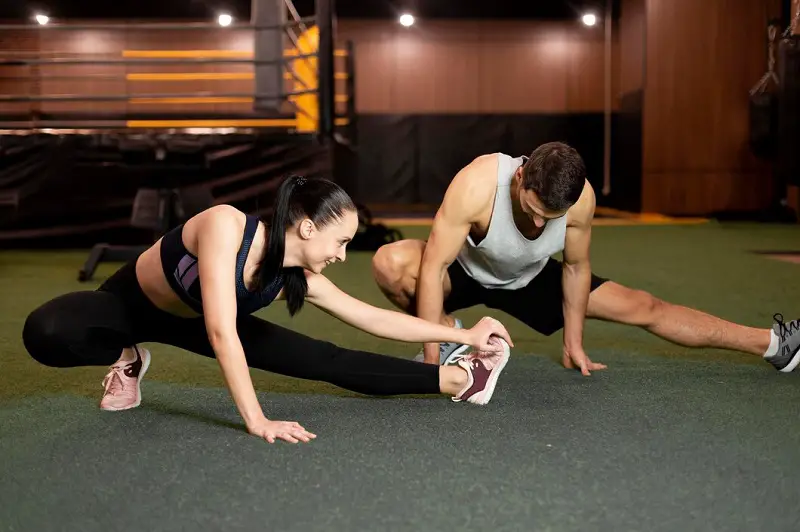
Day 12-14: Flexibility and Balance
Days 12 to 14 of the challenge will focus on enhancing your flexibility and balance. Pilates is known for creating a harmonious balance between strength and flexibility, and these days will emphasize this aspect. Exercises introduced will include The Mermaid, The Side Kick, and The Spine Twist. These exercises aim to stretch and lengthen your muscles, thereby increasing your range of motion and improving your balance and coordination.
Incorporating flexibility exercises into Pilates
Flexibility exercises are an integral part of the Pilates method. They help in lengthening the muscles, increasing the range of motion, and improving the overall body posture. Incorporating flexibility exercises into your Pilates routine will not only enhance your performance in the exercises but also help in preventing injuries.
Enhancing balance and coordination through workouts
Pilates workouts are excellent for improving balance and coordination. Various exercises focus on stabilizing the core while moving the limbs in different directions. This helps in improving body awareness, enhancing coordination among different body parts, and developing better balance. Greater balance and coordination not only enhance your Pilates performance but also contribute to better functional movements in daily life.
Week 3: Challenge and Refinement
Day 15-18: Advanced Pilates Techniques
As we venture further into the third week of the challenge, we’ll start to introduce advanced Pilates techniques. These exercises will stretch your capabilities and push your boundaries, both physically and mentally. Be prepared to test your agility, strength, and endurance like never before. Remember, the key here is not to perfect the exercises instantly but to gradually work towards mastering them with consistent practice.
Pushing boundaries with advanced movements
During these days, you’ll encounter some of the most challenging Pilates exercises, such as the Jackknife, Boomerang, and Control Balance. They require a high degree of control, strength, and flexibility. Although these exercises are demanding, they are also incredibly rewarding, stimulating deep muscle engagement and enhancing your body’s overall functional fitness.
Modifications for different fitness levels
While we’ll be pushing boundaries with advanced movements, we’re mindful that everyone’s fitness level is different. Hence, modifications will be provided for each advanced exercise to ensure you can perform them safely and effectively. These modifications will allow you to gradually upskill and grow stronger without risking injuries.
Day 19-21: Mindfulness and Breathing
Pilates is not just about physical exercises; it’s also a form of mindful movement. Therefore, the final days of the third week will focus on integrating mindfulness and proper breathing techniques into your Pilates practice. This integration will help to boost your exercise performance and mental clarity.
Emphasizing the importance of breathing in Pilates
Breathing is a fundamental element of Pilates. Correct breathing helps to control movements, supply the working muscles with oxygen, and maintain concentration and rhythm. We’ll guide how to effectively inhale and exhale during specific movements, enhancing your Pilates performance and overall wellness.
Mindfulness practices to enhance Pilates performance
Finally, we’ll delve into mindfulness practices that can support your Pilates performance. These practices will help you stay present during your workouts, improve your body awareness, and cultivate a sense of calm that transcends beyond the mat. By incorporating mindfulness into your Pilates practice, you’ll be able to truly experience the holistic benefits of this exercise form.
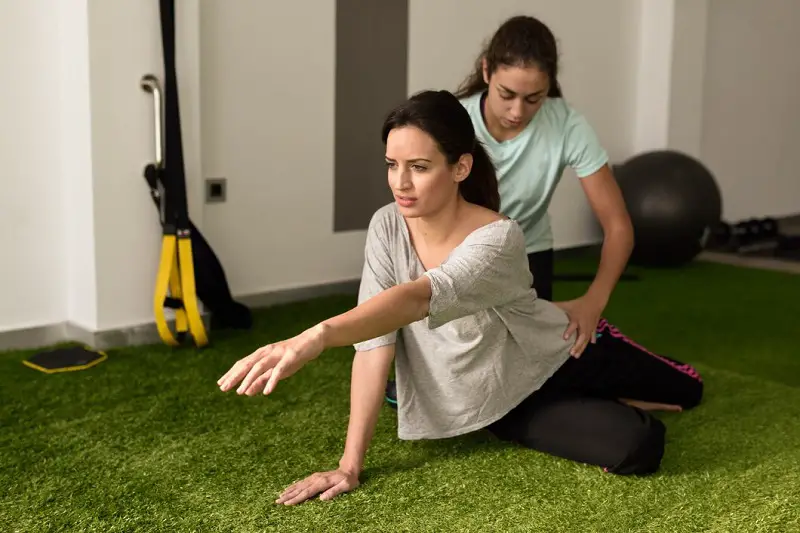
Week 4: Mastery and Sustainability
Day 22-25: Full-body Workouts
Comprehensive routines targeting multiple muscle groups
As we approach the final week, we will focus on full-body workouts that target multiple muscle groups simultaneously. These comprehensive routines will ensure that every section of your body is engaged, promoting balanced strength and flexibility. You will experience exercises that work your core, lower body, and upper body all within a single session, maximizing the efficiency and effectiveness of your workouts.
Building endurance and stamina
Simultaneously, these full-body workouts will be instrumental in building your endurance and stamina. As you perform these comprehensive routines, your cardiovascular fitness will be challenged, and your muscle stamina will be tested. This will lead to noticeable improvements in your ability to perform exercises for a longer duration and recover more quickly from strenuous activity.
Day 26-28: Reflection and Celebration
Reviewing progress over the 28 days
On days 26 to 28, we will take some time to reflect on the progress you have made over these 28 days. We will revisit the goals you set at the beginning and evaluate how far you’ve come. This reflection is crucial in recognizing your achievements and understanding the areas where you need further improvement.
Celebrating achievements and setting future goals
More importantly, these final days will be about celebrating your achievements, big or small. Every step you have taken in this journey deserves recognition and applause. Following this, we will also be setting future goals. Having a goal is instrumental in maintaining your motivation and ensuring that your Pilates journey continues beyond these 28 days. Whether it’s mastering a challenging exercise or improving overall fitness, we will establish clear, achievable targets to work towards.
Conclusion
As we conclude this comprehensive 28-day Pilates challenge, it’s time to absorb the results of your hard work and dedication. You’ve journeyed from understanding the basics of Pilates to performing advanced exercises, and integrating mindfulness into your workouts, and finally, experiencing full-body workouts. You’ve developed strength, flexibility, coordination, and a deeper connection between your mind and body.
Reflect on each step of this course, from the initial warm-up routines to the advanced techniques and mindfulness exercises. Each week presented a new challenge, and you rose to meet it, improving not only your physical strength and stamina but also your mental clarity and focus. You were pushed out of your comfort zone, and you have emerged stronger and more capable.
As we wrap up the challenge, remember that this is just the beginning of your Pilates journey. Consistency is key to maintaining the gains achieved and to continue reaping the benefits of Pilates. Keep the momentum going and make Pilates a mainstay in your fitness routine.
We encourage you to keep exploring the world of Pilates and to continue integrating it into your daily life. Numerous resources, including online platforms, books, and local Pilates studios, can provide further guidance and variety in your workouts. Remember, every small step counts towards a healthier and happier you. Keep moving, keep exploring, and keep challenging yourself. You’ve got this!
Frequently Asked Questions
While the frequency may vary based on individual goals and fitness levels, a general rule of thumb is to practice Pilates 2-3 times a week for the best results. Remember, consistency is key to seeing progress and maintaining the benefits.
Yes, Pilates can be practiced at home or in a studio. Many exercises require only your body weight and can be performed on a mat. However, joining a studio can provide additional equipment-based workouts and guidance from trained instructors.
Pilates is known for its focus on core strength, flexibility, and balance, which can be beneficial for individuals with back pain. However, it is always recommended to consult with a healthcare professional before starting any new exercise regimen, especially if you have a pre-existing condition.

